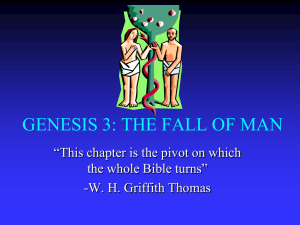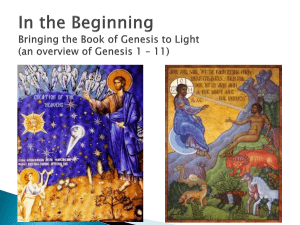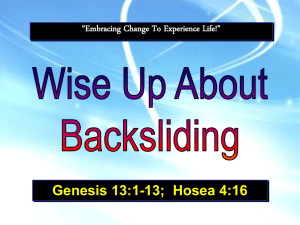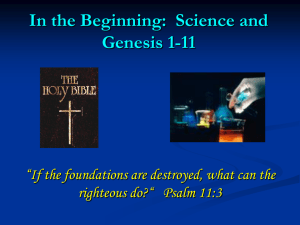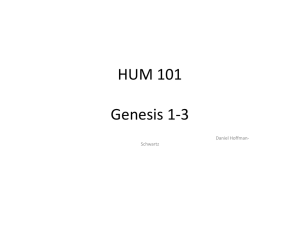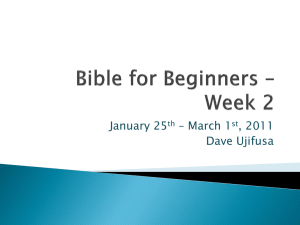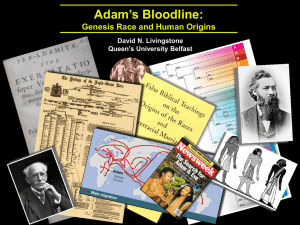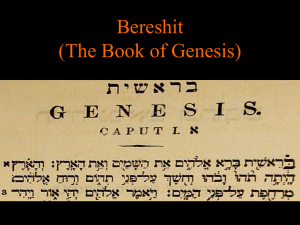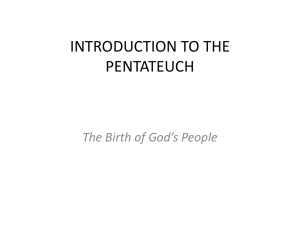GENESIS AND THE BIBLE
advertisement
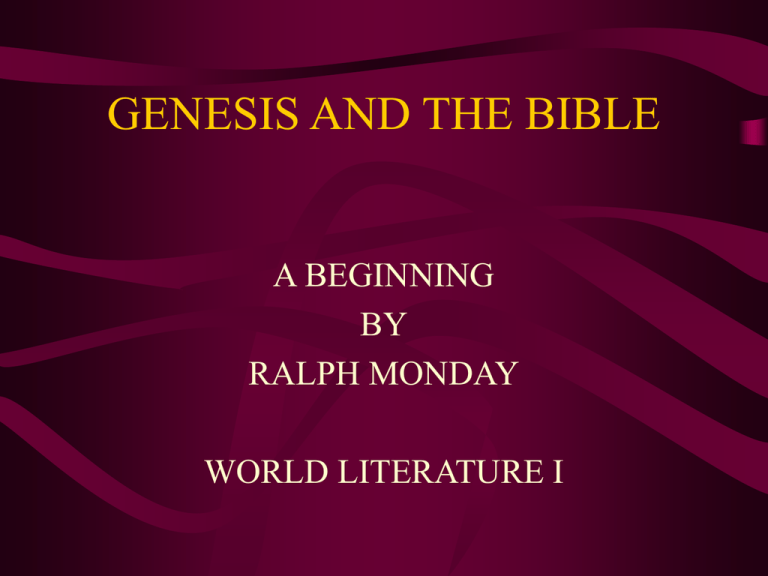
GENESIS AND THE BIBLE A BEGINNING BY RALPH MONDAY WORLD LITERATURE I In the beginning God said “let there be light.” Temptation and expulsion from Eden. Sistine Chapel. Genesis As Historical Narrative • The Pentateuch, of which Genesis is one book, is the core of Judaism, for these five books comprise the • Torah, the law or instruction, that Yahweh gave to Israel through Moses. The Torah contains not only the Ten Commandments, • But also hundreds of statutes, ordinances, and detailed directions for sacrifice and worship that regulated • Every phase of Israel’s daily and religious life. • This is the story of the “chosen” people. The Mosaic Tradition • Traditionally, the first five books of the Bible have been ascribed to Moses’ authorship. • However, in the past two centuries, scholarly analysis has produced a variety of theories to explain the repetitions, inconsistencies, • Stylistic differences, and abrupt shifts in emphasis and theological viewpoint that characterize Genesis through Deuteronomy. • There is one generally accepted theory that attempts to explain these discrepancies. The Documentary Hypothesis • This premise is also called the GrafWellhausen Hypothesis after the 19th century German scholars who presented strong evidence in support of the theory. • This theory states that the Pentateuch is a composite work containing at least four major documentary sources. • Definitely not the inerrant Bible that most of us grew up with. The Two Different Versions • The earliest source of the Pentateuch is called J because the author uses the name Yahweh (in German, Jahweh) for God. • This occurred about 950 B.C.E. This author took Israel’s story all the way back to the creation, and • Told the stories of Adam and Eve, the Flood, Abraham and the other patriarchs, • The exodus from Egypt, and the conquest of Canaan. • The J document is thought to have originated in southern Israel. The Northern E Document • About a century after the J author wrote, a second, northern source for the Pentateuch was compiled. • The northern writer is called E or the Elohist because he uses the generic name Elohim for God, and incorporates into his • Story much older material that had previously been transmitted orally. • Later, an important step was made to combine J and E to produce JE, perhaps around 750 B.C.E. The Meaning of the Word Genesis • Webster’s dictionary defines Genesis as: • Originating from the Greek gignesthai, to become, to be born. • Genesis is an account of creation in the Judeo-Christian world mythos. • There are over 100 creation myths worldwide. • Genesis is the one that is most familiar to the Western world. • Judaism, Christianity, Islam, all share this base Semitic creation story. This beautiful Rendering is Indeed an apt Visual metaphor For the idea of Creation. A more Traditional Rendering is Michelangelo’s Painting in The Sistine Chapel, Where God Is imbuing the Spark of life To Adam. This is the Sixth day of Creation. Historical Cultural Meaning of the Mythos Genesis, from the creation of heaven and earth in chapter 1 to the Descent of Israel’s tribes into Egypt in the concluding chapters, Is a record of historical origins seen through faith. This is its key. The book can be generally divided into four main sections: PART I—Chapters 1-11 explains universal history: creation, the flood, and the origin of various national and linguistic groups. After this prologue Genesis then focuses on the lives of the four great ancestors of The Hebrew people: Abraham, Isaac, Jacob, and Joseph. PART II—Chapters 12-24 emphasizes the story of Abraham, the Ancestor of all Jewish people. The conclusion of the Abrahamic Covenant is the most important part of the narrative. PART III—Chapters 25-36 intermixes the story of Isaac with that Of his son Jacob; Jacob’s twelve sons are the founders of the Traditional twelve tribes of Israel—the genetic progeny of the race Is here inscribed. PART IV—Chapters 37-50, the last section, narrates the story of Joseph and his brothers. This is primarily to explain how the twelve Tribes came to live in Egypt. Genesis concludes with Joseph’s Prophetic hope that Israel will eventually return to Canaan, the Promised Land. This occurred in 1948 with the establishment of a Jewish state, The first since the Diaspora in 70 C.E. when the Romans began To drive the Jewish people out of Canaan. THUS, THE STAGE IS SET, THE PLAYERS ARE ARRANGED, FOR PERHAPS THE MOST POWERFUL CULTURAL MYTHOS THAT THE WESTERN WORLD, AND INDEED EVEN THE ENTIRE WORLD, HAS EVER SEEN-THE WORLD OF THE JUDEO-CHRISTIAN SYSTEM— THE COSMOS OF GENESIS. THIS IS A WORLD THAT STILL POWERFULLY RESONATES FROM ANCIENT HISTORY TO TODAY—OUR WORLD OF TECHNOLOGY, SUPERCOMPUTERS, THE SPACE SHUTTLE— A UNIVERSE THAT DESPITE THE PROBINGS OF SCIENCE, RATIONAL, LOGIC, AND REASON, STILL LOOKS FOR AN EXPLANATION OF LIFE IN THE SUPERNATURAL. THIS IS GENESIS—THE BEGINNING OF BEGINNINGS, ALPHA AND OMEGA, EMBRACING BOTH ORIGINS AND ENDINGS. Let Us Begin the Journey by Exploring the Ancient Past Eden, is one of only Many archetypal Images projecting Into the deep Ancestral past that Attempts to explain The “perfect”state in Which human beings Once existed. This is the “Golden Age.” All cultures Embrace this myth. The Genesis Narrative Genesis begins with a sublime hymn to God’s creative might, and Recounts the six days of creation which culminate in the appearance Of humanity fashioned “in the image of God” (Gen. 1:27). There is an older Babylonian creation myth—the Enuma Elish—that Is similar to Genesis, a polytheistic account, but not one that we are Presently concerned with. In the Genesis mythos, Elohim creates man and woman to reflect his own Divine attributes and to enjoy dominion over the earth and all the Life it contains. In this narrative human beings are the masters of Earthly creation, and the entire creative event is pronounced “very good” (Gen. 1:28-31). Elohim Creating Adam. Creation Of Eve. A more Modern Politically And Religiously Correct rendering (from a WASP Standpoint) Of the creation Of Adam and Eve. The Second Creation Account • Genesis has two distinctly different narratives regarding the creation. • The style and viewpoint of the story abruptly changes in the second chapter. • The second creation account (Gen. 2:4— 25), the J version • Presents a more anthropomorphic view of god. This account refers to God as Yahweh, not Elohim. • God is portrayed as a just but stern father-figure who is capable of suspicion, anger, and defensiveness when his authority is threatened by the first human couple. Differences Between the J and E Accounts In the priestly or E version man and woman are created simultaneously And appear only AFTER all lower forms of life have already been Created. In the second or J version, Adam is made early in the creative process, Then animals are made and Yahweh brings them to Adam to be named. (Gen. 2:18—20). When no animal is acceptable as Adam’s helpmate, Yahweh creates Eve from Adam’s rib. In this account, woman is definitely an afterthought, and she is Instrumental in man’s fall from grace. This second version, the one most commonly taught in the JudeoChristian framework, is a perfect example of what people believe Depending on the cultural mythos taken into one’s psychology. According to J, It is through the Woman that the Mysterious serpent Seduces Adam into Eating the fruit from The Tree of Knowledge Of Good and Evil. Not mentioned as an Apple, just fruit. Here Kitty, Kitty! Adam and Eve being Driven From The Garden After The Fall. Tree of Knowledge Of Good And Evil. After the Fall Yahweh curses man with futile labor and with death; Woman with the pain of childbirth and domination by the male. J’s account answers several age-old questions: Why is life so difficult? Why must we work so hard to live? Why is giving birth so painful? Why must we die? The purpose of a cultural mythos once again: to provide Explanations. An interesting aspect of J’s anthropomorphic portrait of Yahweh Is his vision of the god’s motive for exiling man from paradise. In Genesis 3:22—24, Yahweh interprets man as an incipient rival Who must be prevented from acquiring more godlike attributes. The man, he observes, “has become like one of us, with his knowledge Of good and evil” (possibly a metaphor for knowing everything). Then, so that man will not eat from the Tree of Life “and live forever,” Yahweh banishes the newly weds from Eden and posts an angel with A flaming sword to keep them from the crucial Tree of Life. As late as classical Greece the two major qualities that distinguished The gods from men were the former’s superior knowledge and immortality Since humankind had already acquired forbidden knowledge, Yahweh Prevents their becoming fully like the other divine powers by denying Them everlasting life.

